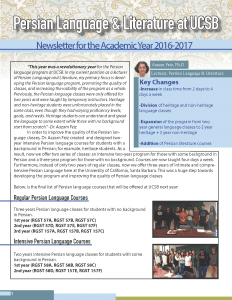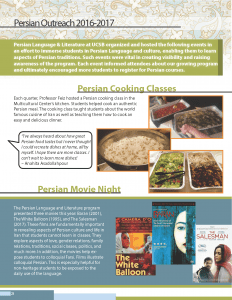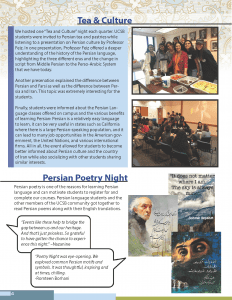The Department of Religious Studies at UC Santa Barbara is proud to offer the most languages of any department on campus. Students can take courses in our department in Arabic, Hebrew (both Modern and Biblical), Persian, and Sanskrit. Depending on instructor availability, the department also offers courses in Coptic, Hindi, Kazakh, Pali, Pashto, Punjabi, Syriac, Tagumic (Aramaic), Tibetan, Turkish, and Vietnamese.
Per the UCSB Course Catalog: Arabic, Hebrew, Hindi, Persian, Punjabi, Tibetan, Turkish, and Vietnamese all count towards Area B (Language) units.
Arabic
Arabic is the world’s third most widespread official language (an official language in 25 countries across the Middle East and Northern Africa) and has over 411 million native speakers. Arabic has a beautiful literary tradition, beginning with the Qur’an, the holy scripture of Muslims, and continuing with centuries of Middle Eastern poetry, philosophy, mathematical and scientific treaties, and novels. In addition to its literary quality, Arabic is an important language for business, government, and economics in the modern world.
The Arabic series is taught over a three year period: one year of Elementary Arabic (RGST 10A, RGST 10B, and RGST 10C), one year of Intermediate Arabic (RGST 10D, RGST 10E, RGST 10F), and a final year of Advanced Arabic (RGST 148A, RGST 148B, RGST 148C). Depending on student demand, courses may also be offered in Egyptian Colloquial Arabic (RGST 10X, RGST 10Y, and RGST 10Z). These Arabic language courses prepare students to take courses exploring Arabic literature, including The Arabic Qur’an (RGST 186B), Readings in South Asian Islamic Texts (RGST 140DX), Readings in Pre-Modern Arabic (RGST 210), Classical Arabic Texts (RGST 288), Guided Readings in the History of Arabic Literature (RGST 289A), Guided Readings in Medieval Arabic Literature (RGST 289B), Guided Readings in Modern Arabic Literature (RGST 289C), and Non-Castilian Literatures of Spain (SPAN 112A).
Arabic language courses are taught by Dr. Wael Hegazy, a scholar of Islamic law, theology, and philosophy. For questions regarding the Arabic courses, placement, and other inquiries, please feel free to contact Dr. Hegazy at wael_hegazy@umail.ucsb.edu.
Please visit UCSB’s Arabic Language Courses page for more information.
Hebrew
The Department of Religious Studies offers courses in both Ancient and Modern Hebrew. Modern Hebrew is one of the two official languages of Israel and is a language with cultural, religious, and political importance.
Hebrew has its origins dating back over three thousand years ago and is the language of composition of the Tanakh (the Hebrew Bible or the Old Testament in the Christian tradition), the Mishnah, and important Jewish legal commentaries in the development of Rabbinic Judaism. Today, the Hebrew language is used in the composition of modern novels, poetry, and religious commentary.
Modern Hebrew is taught over a two-year period. The Elementary Hebrew courses (HEB 1, HEB 2, and HEB 3) are taught in the first-year and introduce students to the alphabet, basic grammar, and basic vocabulary. Intermediate Hebrew courses (HEB 4, HEB 5, and HEB 6) are taught in the second-year. For students interested in Biblical Hebrew, the three-quarter series Introduction to Biblical Hebrew (RGST 17A, RGST 17B, and RGST 17C) introduce students to the orthography, phonology, grammar, and lexicon the Hebrew Bible. Students who have taken the Hebrew series or have prior knowledge of Hebrew can take courses such as Religious Literature in Hebrew (RGST 142A, RGST 142B, and RGST 142C), Introduction to Rabbinic Literature (RGST 131J), Readings in Modern Hebrew Pose and Poetry (HEB 114A, HEB 114B, and HEB 114C), and Non-Castilian Literatures of Spain (SPAN 112A).
Hebrew Language courses can also fulfill certain requirements for the Jewish Studies minor. More information about the Jewish Studies minor and its requirements, can be found at https://www.jewishstudies.ucsb.edu/minor.
Hebrew language courses are taught by Dr. Richard W. Medina, a scholar of the Hebrew Language, Hebrew Bible, and Second Temple Judaism. All inquires related to the Hebrew Language Courses, placement, etc. can be brought to Dr. Medina at richardmedina@ucsb.edu.Please visit UCSB’s Hebrew Language Courses page for more information.
Please visit UCSB’s Hebrew Language Courses page for more information.
Persian
Persian (or Farsi) is an official language of Iran, Afghanistan (as Dari), Russia (as Tat), and Tajikistan (as Tajik), with approximately 130 million speakers. The Persian language has a millennia long history stretching back to the Achaemenid and Sasanian Empires.
Several religious traditions have sacred texts written in the Persian language including Zoroastrians, Manichaeans, and Muslims. The use of the Persian language for religious texts has had a large influence on the diverse literature produced in the Persian language during the medieval period, including the poetry of the Sufi mystic Rumi, the influential Gulistan by Saadi Shirazi, and Ferdowsi’s epic Shahnameh. Persian is an equally important modern literary language with works by world-famous authors such as Nima Yooshij, Simin Behbahani, and Mehdi Akhavan-Sales, among others.
Students who have no prior knowledge of Persian can take Elementary Persian (RGST 57A, RGST 57B, and RGST 57C) followed by Intermediate Persian (RGST 57D, RGST 57E, and RGST 57F) and then Advanced Persian (RGST 157A, RGST 157B, and RGST 157C). Students who already have some background knowledge of Persian listening and speaking may enroll in the Intensive Elementary Persian series (RGST 58A and RGST 58B), followed by the Intensive Intermediate Persian series (RGST 58C and RGST 58D), and finally followed by the Intensive Advanced Persian series (RGST 158E and RGST 58F).
Students who take the language series may also be interested in Persian Translation (RGST 157J), Classic Persian Literature and Translation (RGST 157PP), Persian Language Support (RGST 99PS and RGST 199PS), Persian Language Independent Study (RGST 199PL), Middle East Chorus (MUS A70N and MUS A170N), Contemporary Persian Literature and Translation (RGST 157CP), Persian Cinema (RGST 157G), and Persian Media and Translation (RGST 157I).
Persian Language courses can also fulfill certain requirements for the Iranian Studies minor. More information about the Jewish Studies minor and its requirements, can be found at https://www.religion.ucsb.edu/minor-in-iranian-studies/.
Persian language courses are taught by Dr. Aazam Feiz, a scholar of Persian language and literature, and questions related to the course and placement can be directed to her at afeiz@ucsb.edu. More information about the Persian Language Program can be found at https://persian.religion.ucsb.edu/.
Sanskrit
Sanskrit is a classical language that, while not commonly spoken today, is one of the most important religious and literary languages of human history. As the language of classical Hindu philosophy, Sanskrit is the language of foundational Brahmanic texts (e.g., the Vedas, the Upanishads, the Mahābhārata, and the Rāmāyaṇa), Buddhist texts (e.g., sutras in the Sutrapiṭaka, Vinayapiṭaka and Śāstrapiṭaka collections), and Jain texts (e.g., the Tattvartha Sutra and the Puranas).
Sanskrit is offered in a two-year series. Elementary Sanskrit (RGST 159A, RGST 159B, and RGST 159C) offers students an introduction to the phonology, morphology, and syntax of classical Sanskrit. Intermediate Sanskrit will introduce students to intermediate level Sanskrit religious texts: the Bhadavad-Gita (RGST 159D), the Upanishads (RGST 159E), and various epics (RGST 159F). Students may continue in courses that explore various religious literature in classical Sanskrit: general readings (RGST 159G), Vedic Literature (RGST 159H), the Mahābhārata (RGST 159I), the Puranas (RGST 159J), Yoga Literature (RGST 159K), Philosophical Literature (RGST 159L), Tantric Literature (RGST 159M), Buddhist Literature (RGST 159N), Jain Literature (RGST 159O), and Buddhist Shastras (RGST 159P).
Questions about the Sanskrit language program may be directed to Dr. Gregory Hillis, a scholar of Tibetan and Sanskrit, at ghillis@religion.ucsb.edu.
Other Languages Taught in Religious Studies
These languages have been taught in the past and may be taught again depending on instructor availability. For questions related to these courses, please contact the Religious Studies Chair, Juan Campo, at campo@ucsb.edu.
- Coptic
- Hindi
- Kazakh
- Pali
- Pashto
- Punjabi
- Syriac
- Targumic / Aramaic
- Tibetan
- Turkish
- Vietnamese
As indicated above, some languages are taught more frequently than others and all language courses are subject to instructor availability
Please see the UCSB general course catalog or contact the Religious Studies Department for more information about specific language course offerings.
Languages Taught in other UCSB Departments
For more information about these courses, please contact the appropriate department.
Department of Classics
Greek
Latin
East Asian Languages & Cultural Studies
Chinese
Japanese
Korean
Germanic and Slavic Studies
German
Russian
Department of French & Italian
French
Italian
Department of Spanish & Portuguese
Spanish
Portuguese
Basque
Catalan
Galician















